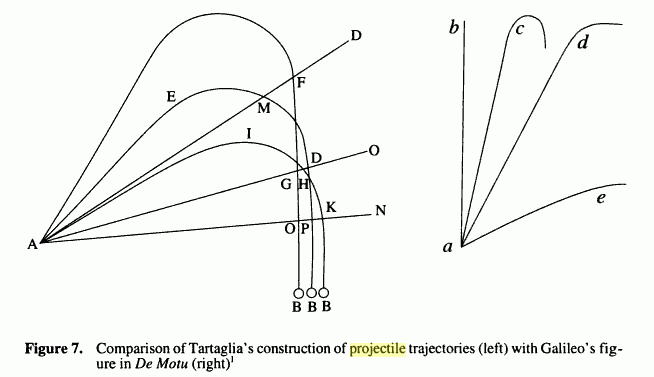Rene Dugas and Maddox, J.R. (tr)
A history of mechanics
Dugas, Rene; Louis de Broglie (intro); Maddox, J.R. (tr);
A history of mechanics [Fr. Histoire de la mécanique, 1950]
Dover Publications (Dover classics of science and mathematics), 1955 / 1988, 662 pages [gbook]
ISBN 0486656322, 9780486656328
topics: | physics | history | science | mechanics
Axiomatic Mechanics of Archimedes
Archimedes, On the Equilibria of Planes
(Introduction and Propositions 1-5b) 1. Equal weights suspended at equal distances (from a fulcrum) are in equilibrium. 2. Equal weights suspended at unequal distances cannot be in equilibrium; and that which is suspended at the greater length is carried down. 3. If weights suspended out from certain distances are in equilibrium, and if one adds something to one of these weights, they are no longer in equilibrium; and the one to which one adds something is carried down. 4. Likewise, if one subtracts something from one of these weights, they are no longer in equilibrium; and the one from which has not subtracted anything is carried down. 5. If equal and similar plane figures coincide, their centers of gravity (of weight) will also coincide. 6. The centers of gravity of unequal but similar figures are similarly placed. 7. If magnitudes suspended at certain distances are in equilibrium, equivalent magnitudes suspended at the same distances will also be in equilibrium. 8. The CG of a figure which is nowhere concave is necessarily within the figure. (see also translations by Henry Mendell, at calstatela.edu) Among propositions proved based on the above axioms were: Proposition II: Unequal weights suspended at equal distances will not be in equilibrium, but the greater weight will fall. [based on postulates 1 and 3] Propositiion III: Unequal weights suspended at unequal distances may be in equilibrium, in which case the greater weight will be at a shorter distance. [from postulates 1, 2 and 4. note: proof does not claim that such an equilibrium exists] Proposition IV: If two equal magnitudes do not have the same CG, the CG of these two is the point at the middle of the line joining their CGs. [from postulate 2, but uses an additional assumption that CG of the composite lies on the line joining the CGs] Proposition VI: Commensurable magnitudes are in equilibrium when they are reciprocally proportional to the distances at which they are suspended. [cites the complete proof, which uses the notion of unit weight Z and unit distance N - the ratio of heavier weight A to Z is shown to be the same as the ratio of the length KH (prop to distance of B) to N. ] [makes several assumptions not in the postulates. The most serious is the hypothesis that the effect of weight P at distance L is the product PL. also assumed by many others before archimedes] The floating bodies are also treated based on similar axiomatic assumptions, and propositions are "proved".
Projectile motion
Nicholas Tartaglia, Nova Scientia(1537)
[Tartaglia spent time analyzing artillery. Before him the Aristotelian
model was that objects go up in a straight line due to the violent
initial motion, and then come down in a straight line.
proposed three phases in the trajectory of a projectile --
modus violentus: rectilinear at any angle, but because _nullum violentum
potest esse perpetuum, this becomes a composite motion (modus mixtus_),
and finally a vertical free fall % (modus naturalis). p.95
the more rapidly a heavy body is thrown in the air, the less heavy it is...
The more the velocity decreases, the more the gravity increases... p.96
[from Galileo in Context, ed. Jürgen Renn:
this theory was influential throughout the 16th c. though it could not
explain the obvious fact that the last vertical projection is never perfectly
straight.
Galileo in his de Motu (c. 1590), accepted Tartaglia's theory, and extended
it by suggesting that objects projected with the same force move further on
a straight line the less acute are the angles they make with the
horizontal. p.49]
 Projectile motion: Trajectories based on tartaglia's model with
three parts
- rectilinear violent motion (modus violentus),
- circular arc (modus mixtus), and
- rectilinear 'natural' motion towards the center of the earth
(modus naturalis)
Second figure: Galileo's initial acceptance and extension of this model
(from Renn: Galileo in context, p. 48)
Projectile motion: Trajectories based on tartaglia's model with
three parts
- rectilinear violent motion (modus violentus),
- circular arc (modus mixtus), and
- rectilinear 'natural' motion towards the center of the earth
(modus naturalis)
Second figure: Galileo's initial acceptance and extension of this model
(from Renn: Galileo in context, p. 48)
Bernardino Baldi, Exercitationes in mechanica (written 1582)
disginguishes - gravity by nature and - gravity by violence (external motive agency) A projectile animated by simple motion of translation [comes to a stop] because nothing which is violent is perpetual... 107 see also Joseph Needham and Ling Wang's Science and Civilisation in China: Physics
amitabha mukerjee (mukerjee [at-symbol] gmail) 2013 Aug 10